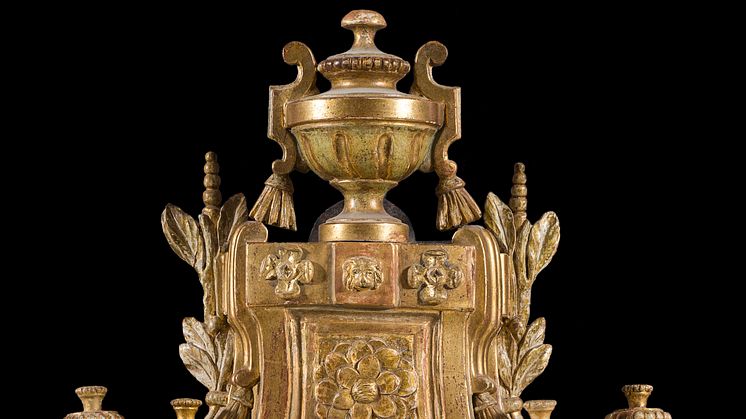
Press release -
New acquisition: Wall clock by Jacob Kock
A Gustavian wall clock, believed to be the only one of its kind, is a welcome new addition to Nationalmuseum’s collection. Dating from 1777, the clock bears the signature of Jacob Kock, clockmaker to the Swedish royal court. However, the main source of interest is neither the clock mechanism nor the gilded wooden case, but the unique clock face in white-glazed faience. To add further interest, the face is signed on the reverse by Petter Oldberg, a faience painter.
The visible side of the clock face bears the customary maker’s mark: “Jacob Kock Stockholm.” Jacob Kock (1737–1805) was admitted as a clockmaker in 1762 and practised his trade until retiring in 1803. One of the most highly skilled clockmakers of the Gustavian era, Kock served as official clockmaker to the court of King Gustav III. He produced a large number of high-quality pieces, mainly pocket watches. At the height of his business, he employed 6–8 journeymen, 3–4 apprentices and “a maid who does the gilding” in his workshop.
The reason why clockmakers signed their work is twofold: producing the mechanism required great skill, and production was generally instigated by the clockmaker. Several other trades were involved in producing the clock. For instance, an ornamental carver made the case, and a gilder was usually responsible for the appearance of the finished article. Normally there was also someone who made the clock face in enameled metal, although these artisans tended to remain anonymous.
As the clock acquired by Nationalmuseum shows, Gustavian-era wall clocks were heavily influenced by contemporary Parisian style in their design. Makers took inspiration from the patterns of Jean Charles Delafosse (1734–89) and others. A crowning urn and floral garlands below the clock face were typical design features, although this clock lost the garlands at some point. Ideally, clock cases would be made in ormolu (fire-gilded bronze), but gilded wood was more commonly used by Stockholm clockmakers.
What sets Nationalmuseum’s new acquisition apart from other similar clocks is a hand-painted signature on the reverse of the clock face, which in translation reads: “Made by Petter Oldberg at Marieberg on 12th Nov. 1777.” The faience painter Petter Oldberg (1745–1807?) was employed at the Marieberg pottery as a journeyman enamel painter from 1768 to 1779. In 1771 he married Anna Elisabet Åhlström, and their son Olof was born in 1779. Oldberg then vanishes from the records before resurfacing in Vyborg, a city on the Gulf of Finland, where his daughter Anna Erica was born in 1781. In the parish register, the father present at the child’s baptism is listed as Petter Oldberg, “enamel painter”, but nothing else is known about his activities in Vyborg.
When the clock was dismantled, a piece of paper containing a drawing of the clock face was discovered between the mechanism and the face. This is believed to be the pattern drawn by Jacob Kock, from which the journeyman enamel painter Petter Oldberg would have worked.
Nationalmuseum’s purchase of this clock was made possible by a generous donation from the Anna and Ferdinand Boberg Foundation, established in 1946 to manage the funds bequeathed by Mr and Mrs Boberg. Nationalmuseum has no budget of its own for new acquisitions, but relies on gifting and financial support from private funds and foundations to enhance its collections of fine art and craft.
Press contacts
Micael Ernstell, Curator, Applied Art and Design
micael.ernstell@nationalmuseum.se, +46 8 5195 4392
Hanna Tottmar, Press Officer
hanna.tottmar@nationalmuseum.se, +46 767 234632
Caption
Jacob Kock and Petter Oldberg, Wall clock, 1777. Photo: Anna Danielsson.
Categories
Nationalmuseum is Sweden’s premier museum of art and design. The collections comprise older paintings, sculpture, drawings and graphic art, and applied art and design up to the present day. The museum building is currently under renovation and scheduled to open again in 2018. In the meantime, the museum will continue its activities through collaborations both in Sweden and abroad as well as temporary exhibitions at the Royal Swedish Academy of Fine Arts, Fredsgatan 12 and Nationalmuseum Design at Kulturhuset Stadsteatern in Stockholm. Nationalmuseum has partnerships with Svenska Dagbladet and the Grand Hôtel Stockholm, and acknowledges the support of FCB Fältman & Malmén.

